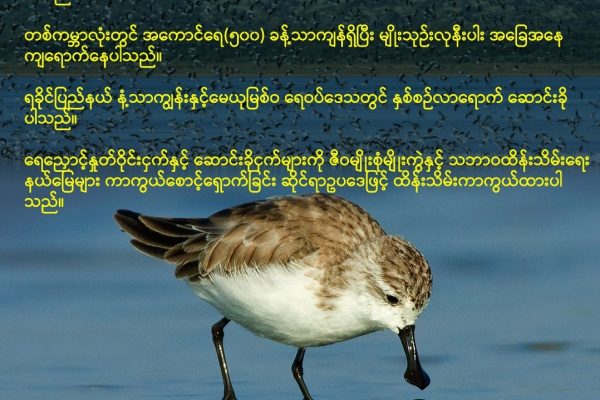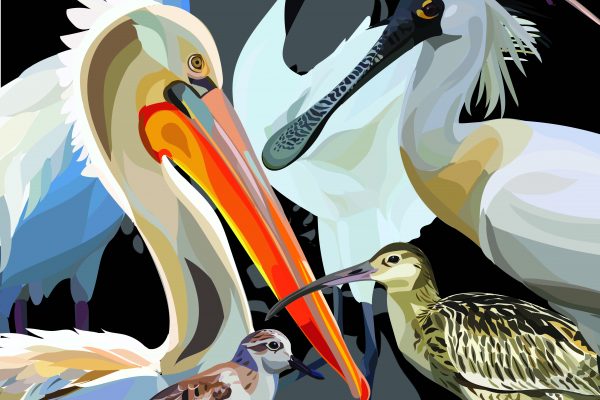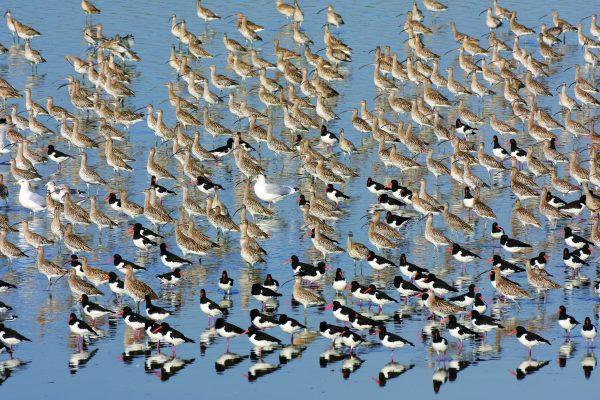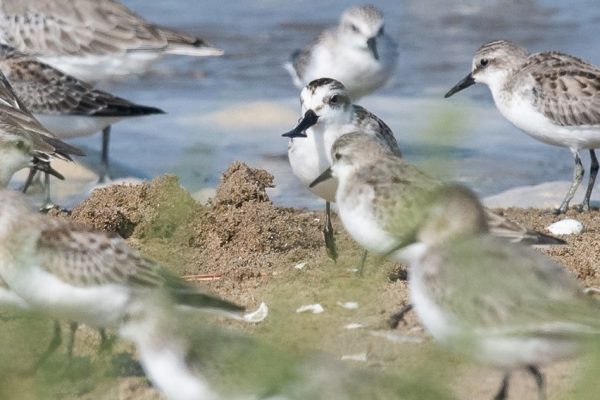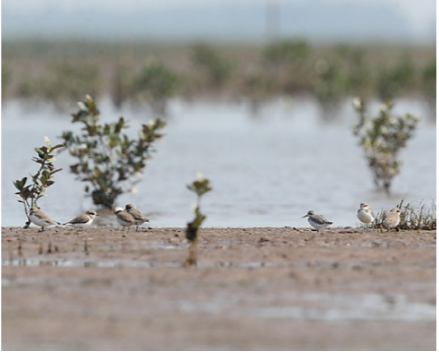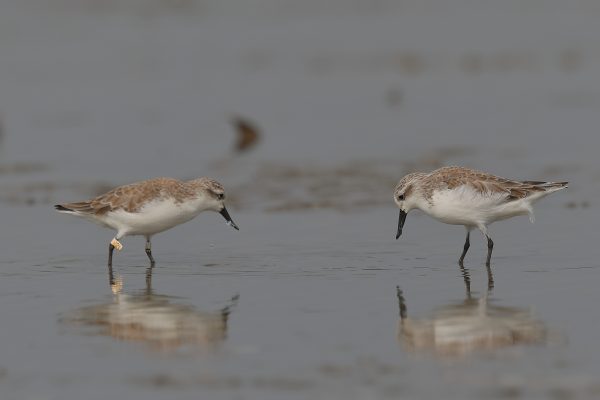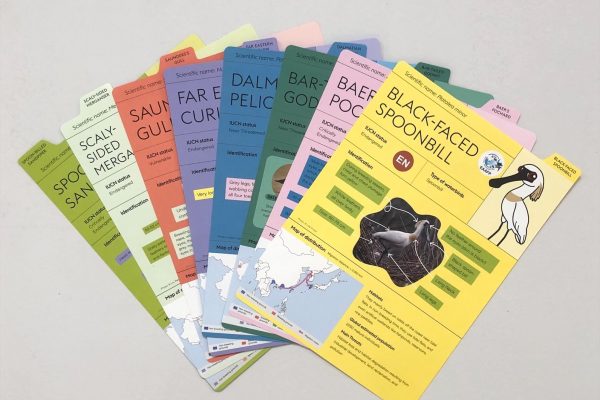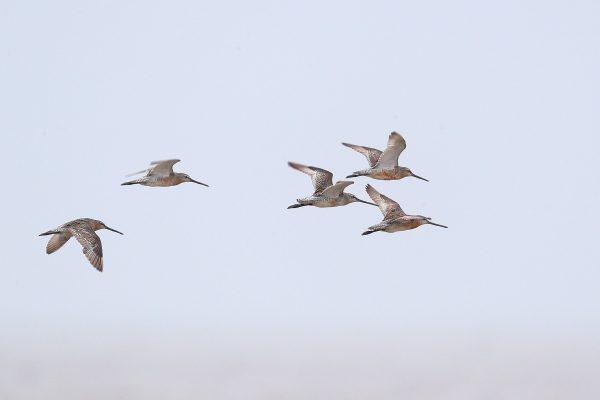-
World Migratory Bird Day 2021 Oct Event – Nature Conservation Society Myanmar
©️ RBANCA Event Title: World Migratory Bird Day event at Nanthar Island and Mayyu Estuary Event Date: 8th – 10th October…
Continue reading -
World Migratory Bird Day 2021 Poster for the East Asian-Australasian Flyway
We are celebrating World Migratory Bird Day (WMBD) twice a year, on every second Saturday of May and October. This day aims to raise awareness of migratory birds and…
Continue reading -
Green Choi’s donation has been successfully delivered to SBS Task Force for Spoon-billed Sandpiper conservation
On 11th August, the EAAFP Foundation has successfully delivered the donation from Ms. Green Choi to the Spoon-billed Sandpiper Task Force (SBS TF) for the conservation of Spoon-billed Sandpiper…
Continue reading -
“Getbol, Korean Tidal Flats” inscribed on UNESCO World Heritage List
On 26th July, 2021, the 44th Session of the World Heritage Committee endorsed the inscription of the Republic of Korea’s tidal flats on the UNESCO World Natural Heritage List, marking an enormous step forward to secure the critical habitats of the Yellow Sea for millions of migratory waterbirds that depend on this area as a vital stopover on their migratory journeys from as far away as Australia and New Zealand to breeding grounds in Arctic Russia and Alaska. Great Knot and Bar-tailed Godwit ©WH Promotion Team of Korean Tidal Flat The inscription of the “Getbol”, the Korean name for tidal flats, was announced during the World Heritage Committee meeting held in Fuzhou City, China and follows over 10 years of intensive preparation by the Korean authorities. The four sites included in the Phase I inscription of Seocheon Getbol, Gochang Getbol, Shinan Getbol and Boseong-Suncheon Getbol, collectively cover over 128,000 hectares of coastal wetlands in the Southwestern part of the country. Additional areas will be added as part of a Phase II nomination. The shallow waters in the Yellow Sea region jointly shared by China, DPR Korea and Ro Korea hold some of the largest and most spectacular intertidal wetlands in the world. These sites support exceptionally rich biodiversity, but are best known for some of the largest congregations of migratory waterbirds in eastern Asia, many of which are globally threatened by habitat loss along their migratory pathways, collectively known as the East Asian – Australasian Flyway. Up to 100,000 shorebirds use the mudflats around Yubu island in the Seocheon Getbol during migration, including the Critically Endangered Spoon-billed Sandpiper and the Endangered Far Eastern Curlew. Other species, such as Vulnerable Saunders’s Gull and Endangered Black-faced Spoonbill stay to nest in the coastal wetlands of the Yellow Sea. “The inscription of the Getbol in the World Heritage List will mark a great shift of paradigm for Getbol tidal flats protection and management policy, as well as the increasing public awareness. The Getbol's World Heritage inscription means that the tidal flats managed by locals become a shared global property for the next generation of all humanity. All stakeholders involved with the Getbol will make the best effort to complete its Phase II extension and even further in the future.’’ said Dr. Kyong-O Moon, the Secretary-General of the Korea Getbol World Heritage Promotion Team. “The Korean Getbol inscription complements the “The Migratory Bird Sanctuaries along the Coast of the Yellow Sea-Bohai Gulf of China (Phase I)” World Heritage Site listed in 2019. It will strengthen international collaboration, particularly in the vision of transboundary joint efforts with China and DPR Korea, to conserve the wetlands of the Yellow Sea region, the irreplaceable migration hub for migratory waterbirds shared by the 22 countries in the Flyway,” said Mr. Doug Watkins, Chief Executive of EAAFP, an international partnership to conserve migratory waterbirds along the Flyway. “The UNESCO World Heritage Convention offers an exceptionally powerful framework to secure the future of globally important biodiversity. The BirdLife International Partnership look forward to working closely with the EAAFP and IUCN to secure the same status for the remaining such areas of the Yellow Sea, and to support the authorities to ensure all receive the best possible management for birds and people.’’ said Dr. Ding Li Yong, BirdLife International (Asia Division) Flyways Coordinator. Decision paper (download at: https://whc.unesco.org/en/sessions/44COM/documents/#amendment ) Far Eastern Curlew and others © WH Promotion Team of Korean Tidal Flat Black-faced Spoonbill © WH Promotion Team of Korean Tidal Flat Spoon-billed Sandpiper ©WH Promotion Team of Korean Tidal Flat Hooded Cranes in Suncheon Bay ©WH Promotion Team of Korean Tidal Flat Click [here] for the UNESCO WHC official announcement. Click [here] for the local news media archive. Local news reports: Korean Version: 한국의 갯벌’, 유네스코 세계유산 등재 2021년 7월 26일 ‘한국의 갯벌’은 제 44차 세계유산위원회(WHC)에서 유네스코 세계자연유산으로 등재 됐다. 이 지역은 뉴질랜드· 호주부터 러시아 알래스카까지 이동하는 수백만 마리 철새의 황해 상 중간기착지로서 세계적으로 중요하고 의미있는 서식지 보전에 매우 큰 발걸음이 되었다. 중국 푸저우에서 열린 제44차 세계유산위원회는 한국의 갯벌을 세계자연유산 등재로 최종 확정했다. 이는 한국이 10년 간 준비한 작업의 성과라고 볼 수 있다. 1단계 세계자연유산 대상지로는 서천갯벌, 고창갯벌, 신안갯벌, 보성-순천갯벌, 4곳으로 총 12만8000ha가 넘는 서남해해안 습지이다. 2단계 추진과정에서 추가지역들이 포함될 예정이다. 중국과 남북한이 공유하고 있는 황해지역은 세계에서 가장 크고 장관을 이루는 조간대 습지다. 이 지역은 생물다양성이 매우 풍부하고, 최대 규모 집단인 동아시아 지역의 이동성 물새 서식지 감소로 인해 전 세계적으로 가장 위협을 받는 지역이며, 동아시아-대양주 철새이동경로 상에 있다. 멸종위기에 처한 넓적부리도요, 알락꼬리마도요를 포함 한 최대 10만 마리까지 이동 기간동안 유부도 주변(서천 갯벌)을 이용한다. 또한 취약종인 검은머리갈매기와 멸종위기종 저어새와 같은 다른 종은 황해 연안 습지에 둥지를 튼다. 한국 갯벌 세계유산 등재추진단 문경오 사무국장은 “한국의 갯벌 유네스코 세계유산 등재는 갯벌 보호 및 관리 정책의 패러다임을 전환하는 계기가 될 것 이며, 대중 인식 증진에도 큰 기여를 할 것이다.” 이어서 “한국의 갯벌 유네스코 세계유산 등재는 지역 주민이 관리하는 갯벌에서 더 나아가 전 지구적으로 공유하는 자산으로 모든 인류를 포함하여 다음 세대에 넘겨줄 자산이 된다는 의미다. 갯벌과 관련된 모든 이해관계자들은 2단계(Phase II) 상향과 향후 더 확장할 수 있도록 최선을 다할 것이다” 라고 말했다. 국제철새보호 기구 동아시아-대양주 철새이동경로 파트너십(EAAFP) 사무국 더그 와킨스(Doug Watkins) 대표는 “한국 갯벌 등재는 2019년 세계유산에 등재된 ‘중국 황하이 연안-보하이 만의 철새 보호구역(1단계)’을 보완한다. 특히 국경을 넘어 공동 비전인 황해 보전을 위해 중국과 남북한의 국제 협력과 황해 지역의 습지를 보전하여 대처할 수 없는 22개국이 함께 공유하는 철새이동경로 보전 노력이 강화 될 것” 이라고 말했다. 딩리 용(Ding Li Yong) 버드라이프 인터내셔널(BirdLife International) 아시아 지부 이동경로 코디네이터는 “유네스코 세계유산협약은 세계적으로 중요한 생물다양성의 미래를 보장하기 위한 매우 강력한 프레임워크를 제공한다. 버드라이프는 EAAFP및 유네스코 심사 자문기구인 세계자연보전연맹(IUCN) 과 긴밀히 협력하여 황해의 나머지 지역에도 동일하게 보전을 확보하여 당국이 조류와 인류을 위한 최상의 관리를 받을 수 있도록 지원하기를 기대한다” 라고 말했다.
Continue reading -
“Flyway: connecting people and migratory waterbirds” story series #11 – Ms. Jing Li, Co-Founder of Spoon-billed Sandpiper in China
If you are aware of conservation work for Spoon-billed Sandpiper, you may have heard about Spoon-billed Sandpiper in China (SBSinChina), a local NGO aiming to protect this Critically Endangered…
Continue reading -
Getting Getbol (intertidal mudflats) of the Republic of Korea into World Natural Heritage Site inscription
Spoon-billed Sandpiper in Yubudo © Henrik Thorlund The West/Yellow Sea, lies at the heart of the East Asian-Australasian Flyway, a migratory route for 50 million migratory waterbirds traverse on an annual basis which stretches from Russia Far East and Alaska, U.S.A. south to Australia and New Zealand covering 22 countries. This region is surrounded by three countries: The People’s Republic of China, the Democratic People’s Republic of Korea (DPR Korea) and the Republic of Korea (RO Korea). The wetland habitats in this region, especially the intertidal mudflat in this area serve as fuelling, staging stations for two million shorebirds, or 40% of total birds in the Flyway, annually. However, the intertidal mudflat in this region has shrunk by over 65% in past decades, but recent studies in countries outside the Yellow Sea region showing rapid declines of migratory shorebirds strongly related to the loss of the birds’ habitats in the West/Yellow Sea. This illustrates the sites in different countries along the Flyway are highly interconnected due to the migratory waterbirds, and it is crucial to protect, as it is one of the world’s most important migratory bottlenecks for watebirds. The Government of the Republic of Korea has nominated 4 sites of intertidal mudflats, or “Getbol” in Korean, on the country’s southwestern coast of the Yellow/West Sea as the candidate of UNESCO’s World Heritage listing. This group of four sites included in the Phase I nomination are Seocheon Getbol (EAAF101), Gochang Getbol, Shinan Getbol (EAAF146) and Boseong-Suncheon Getbol (EAAF079), covering over 128,000 ha (or 1280 km2) of wetlands. Apart from its spectacular geological processes, these areas are rich in biodiversity, with 2,169 invertebrate species, 857 macrobenthos, 152 marine macroalgae, 47 endemic and 5 endangered marine invertebrate species recorded. The richly diverse benthic community supports a huge number of migratory waterbirds. In addition, the endangered Narrow-ridged Finless Porpoise is often found in the waters within the nominated sites. Hooded Crane in Suncehon Bay © Suncheon City Office Bird surveys have revealed that these sites supported 102 waterbird species and some 34 species with internationally important numbers. The sites were crucial for 15 globally threatened waterbird species including Spoon-billed Sandpiper (CR), Far Eastern Curlew (EN), Nordmann’s Greenshank (EN), Great Knot (EN), Black-faced Spoonbill (EN), Hooded Crane (VU), Saunders’s Gull (VU), Chinese Egret (VU) Swan Goose (VU), Relict Gull (VU), Horned Grebe (VU), White-naped Crane (VU) and Common Pochard (VU). The nomination would also secure the reintroduced population of Oriental Stork (EN). Legflag observations and satellite tracking data furthered confirmed the nominated sites interlinked with other countries in the Flyway. Because of such ecological connectivity of the migratory waterbirds along the Flyway, the World Heritage inscription is not just a matter to the Republic of Korea, as it contributes to assuring that the critical staging area for migratory waterbirds in the Flyway is secured. It is essential to safeguard the integrity of Yellow/West Sea intertidal flat, together with the on-going designation of World Heritage Sites along China coast of the Yellow Sea and potentially with the habitats along DPR Korea at a future date. The future of millions of migratory waterbirds now lay on the hands of the World Heritage Committee to agree on the “Outstanding Universal Value” of this Getbol nomination. The result announcement for this nomination will be made at the upcoming annual meeting of the World Heritage Committee in China in July 2021. Watch the video about the Getbol: Click [here] or the image to enjoy the photo book: Suncheon Bay © Suncheon City Government
Continue reading -
New site in the Gulf of Tonkin coast of northern Vietnam for Spoon-billed Sandpiper
Introduction The coastal wetlands along the shallow Gulf of Tonkin spanning northern Vietnam and southern China (including the island of Hainan) are known to provide critical wintering habitat for several…
Continue reading -
2021 South China Spoon-billed sandpiper (SBS) winter census
Abstract China SBS winter census is conducted annually to assess the distribution and population of this critically endangered species. This year, the census…
Continue reading -
Lianyungang, an important yet overlooked stopover site in the southern Yellow Sea
A Dalmatian Pelican is making Lianyungang pancakes for an Asian Dowitcher, a Eurasian Oystercatcher and an Ancient Murrelet. All four birds rely on Lianyungang during their annual migration. Illustrator © Nemo. Over the past few decades, people have come to realise that tidal flats along the Yellow Sea-Bohai Bay are of paramount importance to migratory shorebirds along the East-Asian Australasian Flyway (hereafter EAAF). For example, several sites along the southern Jiangsu province of China have been recognised as the critical staging ground for globally endangered shorebirds such as the Spoon-billed Sandpiper and Nordmann’s Greenshank. The improving awareness and knowledge were followed by varying degrees of conservation efforts. The most successful story was probably Tiaozini, the most important stopover site for Spoon-billed Sandpipers. In 2019, Tiaozini was included in the scope of natural World Heritage Site, which is the highest level of habitat protection and conservation in China. Unfortunately, sites without stable records of charismatic species like the Spoon-billed Sandpiper has been given little attention. Lianyungang, a long-overlooked coastal jewel Lianyungang is a coastal city located in northeastern Jiangsu. With the Yellow Sea on its east, Lianyungang is roughly 300km north of Tiaozini. There are over ten major estuaries along its 212km coastline, creating vast areas of coastal tidal flats. Probably due to the lack of charismatic species, Lianyungang has been largely overlooked. Waterbird surveys in this area had mostly been conducted by a single volunteer in the past decade, meaning that temporal and spatial coverage were often limited. During May 09-13, 2019, a non-profit organisation called Spoon-billed Sandpiper in China (hereafter SBSinChina) recruited ten experienced surveyors in an effort to conduct a comprehensive waterbird survey in Lianyungang. They found that significant numbers of several shorebird species rely heavily on the Lianyungang coast during northward migration. Locations of the major survey sites, as well as the location of Lianyungang on the east China coast (inset map). Solid lines and dashed lines represent the area of tidal flat and high-tide roost surveyed during May 09-13, 2019. Credit: Google map. Important findings in Lianyungang During the five-day survey, SBSinChina recorded 30 species of 109,028 shorebirds. On May 12, 2019, over 22,432 Asian Dowitchers were recorded at the Qingkouhe tidal flat, which constitutes 97.5% of Asian Dowitchers’ global population estimate. This is by far the highest number of Asian Dowitchers recorded at a single site. The high concentration of Asian Dowitchers at Qingkouhe tidal flat, Lianyungang on May 12, 2019 © Ziyou Yang. Over 3,500 Black-tailed Godwits was recorded on the Xingzhuanghe tidal flat on May 10, 2019, which constitutes 2.2% of its estimated global population. During the five-day survey, the surveyors observed 41 individually flagged Black-tailed Godwits, of which 38 were recorded on the Xingzhuanghe tidal flat. Among those flagged individuals, most were only previously observed at Broome, Western Australia, so the survey results filled a gap in the species’ stopover site and migration strategy. Some of the individually-flagged Black-tailed Godwits recorded on the Xingzhuanghe tidal flat during May 09-13, 2019 © Yongxiang Han. Several other shorebird species, such as Lesser Sandplovers (15.6% of EAAF population), Sharp-tailed Sandpipers (6.9%) and Broad-billed Sandpipers (5.5%) were also recorded in significant numbers on the Lianyungang coast. More details can be found in the 32nd issue of BirdingAsia. It’s no coincidence! SBSinChina’s survey results suggested that Lianyungang is the most important stopover site for Asian Dowitchers during northward migration. In autumn 2019 and spring 2020, SBSinChina carried out additional surveys on the Lianyungang coast. They confirmed that the record-breaking number of Asian Dowitchers observed in spring 2019 was not a coincidence, because over 20,000 individuals were recorded in Lianyungang exactly one year later. They also discovered that Lianyungang is crucial to Asian Dowitchers and some other shorebird species during southward migration, supporting at least 28.5% Asian Dowitchers, 6.6% Black-tailed godwits and 5.1% Great Knots on a single day in August 2020. An elegant Asian Dowitcher in Lianyungang © Zhenhong Hu. Asian Dowitchers were flying above the Qingkouhe tidal flat © Zhenhong Hu. Conservation Implications While the discovery of a critical stopover site is exciting, when the majority of Asian Dowitchers aggregate at one single site during northward migration, they become very susceptible to human activities and/or stochastic events. Currently, the conservation status of Asian Dowitcher is Near Threatened. Although comprehensive, long-term monitoring data is lacking, SBSinChina suspects that the population of Asian Dowitchers may have declined. Given its highly concentrated distribution and suspected decrease in population, the conservation status of Asian Dowitchers may need re-assessment by the IUCN committee to warrant timely conservation of the species. SBSinChina is currently gathering data to reassess the population and distribution of Asian Dowitchers in China and beyond. Although Lianyungang does not boast charismatic species like Tiaozini, it does support significant numbers of other shorebirds that are key components of ecosystems along the EAAF. Currently, coastal wetlands on the Lianyungang coast are largely unprotected. Shorebirds still face multiple threats including tourism development, Spartina invasion and lack of suitable high-tide roosts. The indifferent attitude adopted by the local government towards conservation is not helping. The aerial view of the Blue Bay tourism development project near Linhonghe tidal flat © Dihai Chen. Based on the survey results, SBSinChina recommends that survey efforts should be continued in Lianyungang to inform conservation and management actions. They also suggest that key stakeholders work together to include Lianyungang in phase II of the serial natural World Heritage nomination. Together with other sites along the Yellow Sea-Bohai Bay coast, Lianyungang can provide rich ecosystems to serve both migratory waterbirds and local communities. Article link: https://www.orientalbirdclub.org/birdingasia-32 Prepared by Yang Ziyou from Spoon-billed Sandpiper in China.
Continue reading

